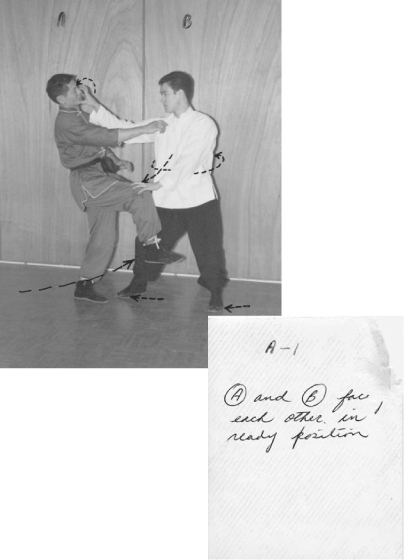
It was a difficult decision whether to include the following pictures and annotations as an extra section within the pages of this book. It was difficult because obviously these pictures were not originally intended for this book and also because we had very little information on the origin and intent of these photos.
It seems clear that had my father wished to include these in a revised edition of this book or any other, then he would have. It also seems clear, however, that at some point in time he did take these pictures and annotate them with the idea of a book in mind. Whether he ever finished the photos and text for this new book idea or whether his evolution just took him away from the idea behind this book altogether, we will never know.
As my mother mentioned in her foreword at the beginning of the book, my father eventually moved away from the continued publication of Chinese Gung Fu as his beliefs about the martial arts evolved. Time, however, has shown that the evolutionary steps and rudimentary knowledge of Bruce Lee continue to be of great interest to the martial arts world. It is for this reason that we chose not only to reprint Chinese Gung Fu but also to include more material that offers an insight into my father’s evolution and base of knowledge.
The photos and annotations that are in this section do not make up the pages of a complete volume or even a complete thought. Rather, these are a collection of photos and notes that are more of a glimpse into the process of Bruce Lee’s martial experience. They are presented to you in raw form because we, and the editors, did not want to assume any kind of interpretation. We hope you will find these pages as interesting as we do and will take the time to look through them with a thorough eye toward the martial art they impart. In his desire to teach, my father was the consummate student. If nothing else, these pages stand as a testament to a man who was passionate about the martial arts and who wanted to share his experience with others.
S. Lee
2008

A-1
A–1 A and B face each other in ready position.

A-2
A–2 In ONE moti[on], A locks B’s [right] hand and strikes his throat simultaneously. (Note the locking of B’s leg for prevention of kicks.)
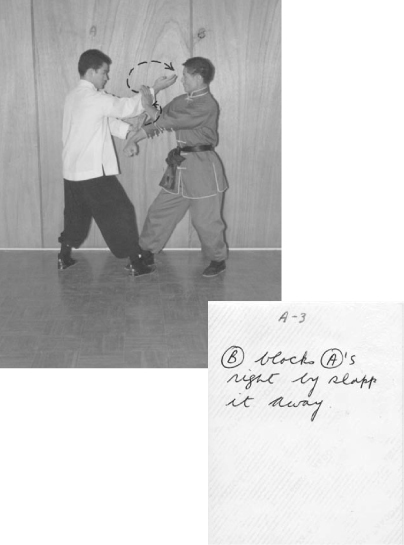
A-3
A–3 B blocks A’s right by slap[ping] it away.
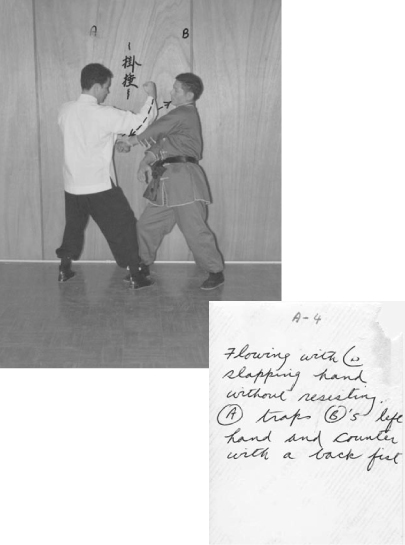
A-4
A–4 Flowing with B, […] slapping hand without resisting. A traps B’s left hand and counter[s] with a back fist.

A-5

A-6
A–5, 6 Closing in, [A] comes in with two straight [punches] as shown in the following two pictures. (Observe how B is “locked” without any striking or kicking room.)
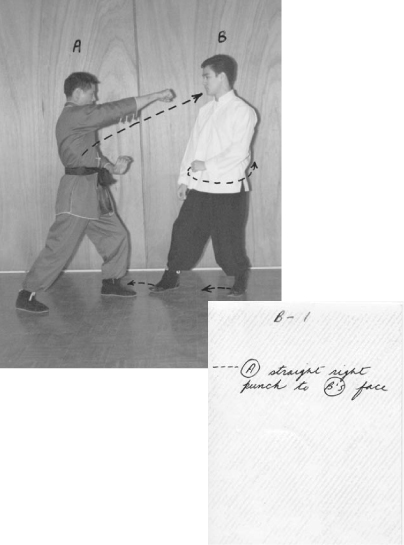
B-1
B–1 A straight right punch[es] to B’s face.

B-2
B–2 Advancing, B deflects A’s punch and strike[s] him simultaneously by turning his waist. The deflection should be outward and upward without over-reaching, thus going off the body.
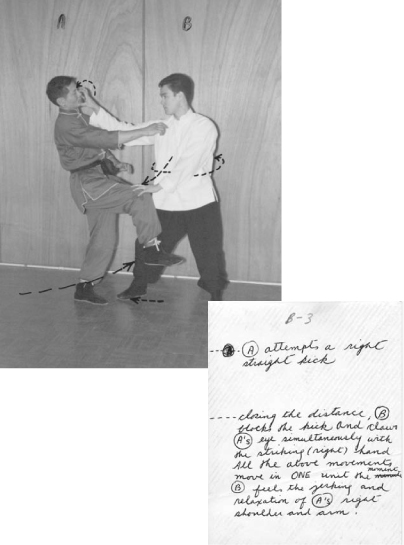
B-3
B–3 A attempts a right straight kick. Closing the distance, B blocks the kick and claws A’s eye simultaneously with the striking (right) hand. All the above movements move in ONE unit the moment B feel[s] the jerking and relaxation of A’s right shoulder and arm.

C-1
C–1 This is a classical Gung Fu technique. A right straight punch[es] in [a] bow and arrow stance. B right forearm block[s].
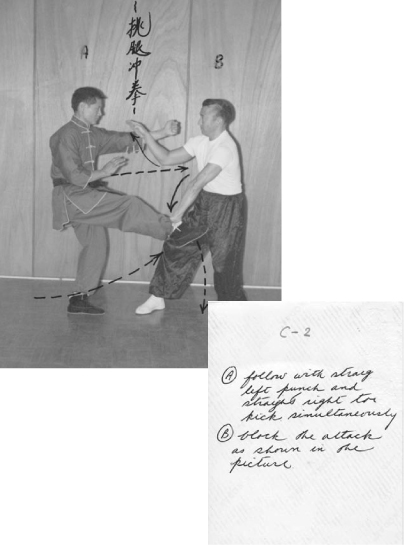
C-2
C–2 A follows with [a] straig[ht] left punch and [a] straight right toe kick simultaneously. B block[s] the attack as shown in the picture.
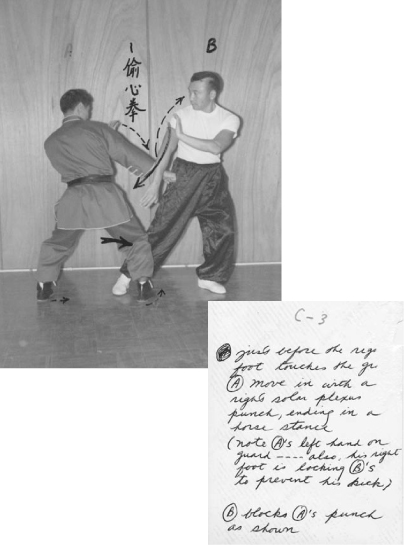
C-3
C–3 Just before the right foot touches the [ground], A move[s] in with a right solar plexus punch, ending in a horse stance. (Note: A’s left hand [is] on guard—also, his right foot is locking B’s to prevent his kick.)
B blocks A’s punch as shown.
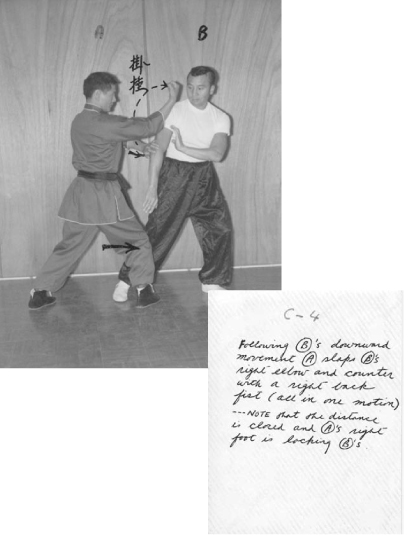
C-4
C–4 Following B’s downward movement, A slaps B’s right elbow and counter[s] with a right back fist (all in one motion). Note that the distance is closed and A’s right foot is locking B’s.
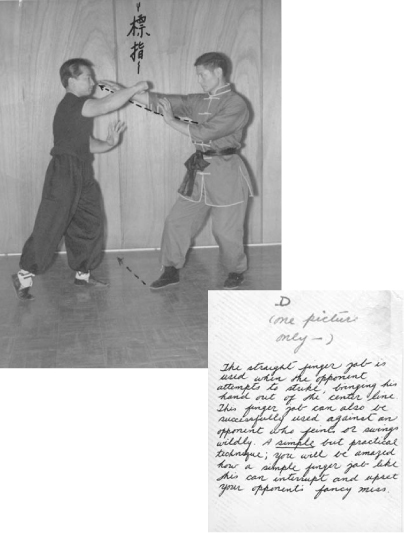
D
D (One picture only.) The straight finger jab is used when the opponent attempts to strike, bringing his hand out of the center line. This finger jab can also be successfully used against an opponent who feints or swings wildly. A simple but practical technique; you will be amazed how a simple finger jab like this can interrupt and upset your opponent’s fancy mess.
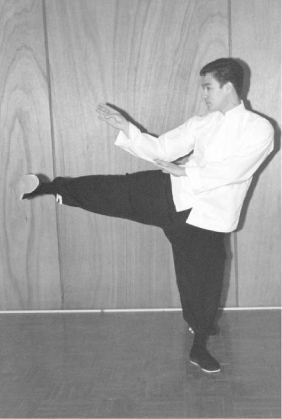
E-1
Publisher’s Note: Because Mr. Lee left no annotations behind for photos E–1 through E–6, we are leaving them in their original format.
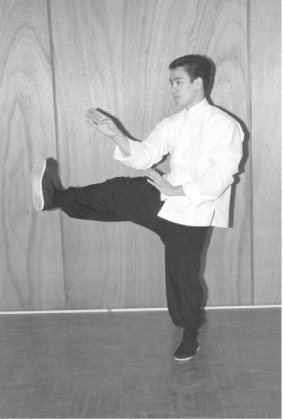
E-2
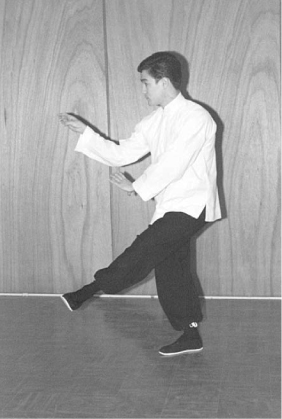
E-3

E-4

E-5

E-6
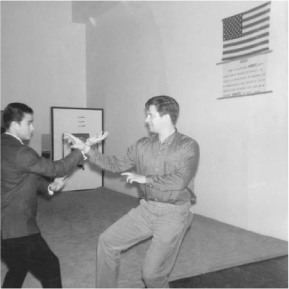
The following are some photos taken at Ralph Castro’s Kenpo Karate Studio in San Francisco during a visit. It shows the author (left) and Ed Parker in Bi Jong, or ready position.
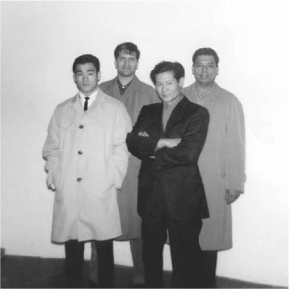
From left to right: Author, Ed Parker, James Lee and Ralph Castro.
Publisher’s Note: Ed Parker and Ralph Castro were black belt Kenpo Karate instructors.
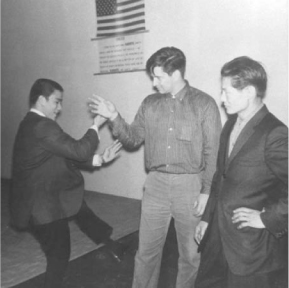
From left to right: Author with Ed Parker and James Y. Lee during Gung Fu gabfest.
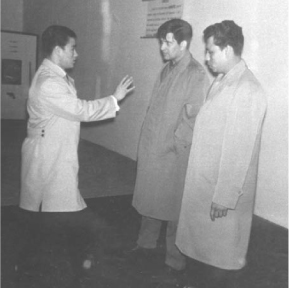
From left to right: Author with Ed Parker and Ralph Castro in Castro’s spacious studio.